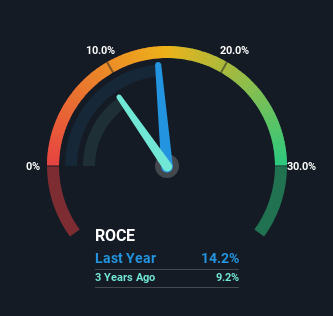Returns On Capital Are Showing Encouraging Signs At Bloomsbury Publishing (LON:BMY)
What trends should we look for it we want to identify stocks that can multiply in value over the long term? Ideally, a business will show two trends; firstly a growing return on capital employed (ROCE) and secondly, an increasing amount of capital employed. Put simply, these types of businesses are compounding machines, meaning they are continually reinvesting their earnings at ever-higher rates of return. So when we looked at Bloomsbury Publishing (LON:BMY) and its trend of ROCE, we really liked what we saw.
Understanding Return On Capital Employed (ROCE)
For those that aren't sure what ROCE is, it measures the amount of pre-tax profits a company can generate from the capital employed in its business. To calculate this metric for Bloomsbury Publishing, this is the formula:
Return on Capital Employed = Earnings Before Interest and Tax (EBIT) ÷ (Total Assets - Current Liabilities)
0.14 = UK£28m ÷ (UK£307m - UK£112m) (Based on the trailing twelve months to August 2023).
Thus, Bloomsbury Publishing has an ROCE of 14%. In absolute terms, that's a satisfactory return, but compared to the Media industry average of 11% it's much better.
Check out our latest analysis for Bloomsbury Publishing

In the above chart we have measured Bloomsbury Publishing's prior ROCE against its prior performance, but the future is arguably more important. If you'd like, you can check out the forecasts from the analysts covering Bloomsbury Publishing for free.
What Can We Tell From Bloomsbury Publishing's ROCE Trend?
The trends we've noticed at Bloomsbury Publishing are quite reassuring. The data shows that returns on capital have increased substantially over the last five years to 14%. The amount of capital employed has increased too, by 39%. So we're very much inspired by what we're seeing at Bloomsbury Publishing thanks to its ability to profitably reinvest capital.
In Conclusion...
All in all, it's terrific to see that Bloomsbury Publishing is reaping the rewards from prior investments and is growing its capital base. Since the stock has returned a staggering 173% to shareholders over the last five years, it looks like investors are recognizing these changes. With that being said, we still think the promising fundamentals mean the company deserves some further due diligence.
One final note, you should learn about the 2 warning signs we've spotted with Bloomsbury Publishing (including 1 which can't be ignored) .
While Bloomsbury Publishing may not currently earn the highest returns, we've compiled a list of companies that currently earn more than 25% return on equity. Check out this free list here.
Have feedback on this article? Concerned about the content? Get in touch with us directly. Alternatively, email editorial-team (at) simplywallst.com.
This article by Simply Wall St is general in nature. We provide commentary based on historical data and analyst forecasts only using an unbiased methodology and our articles are not intended to be financial advice. It does not constitute a recommendation to buy or sell any stock, and does not take account of your objectives, or your financial situation. We aim to bring you long-term focused analysis driven by fundamental data. Note that our analysis may not factor in the latest price-sensitive company announcements or qualitative material. Simply Wall St has no position in any stocks mentioned.
